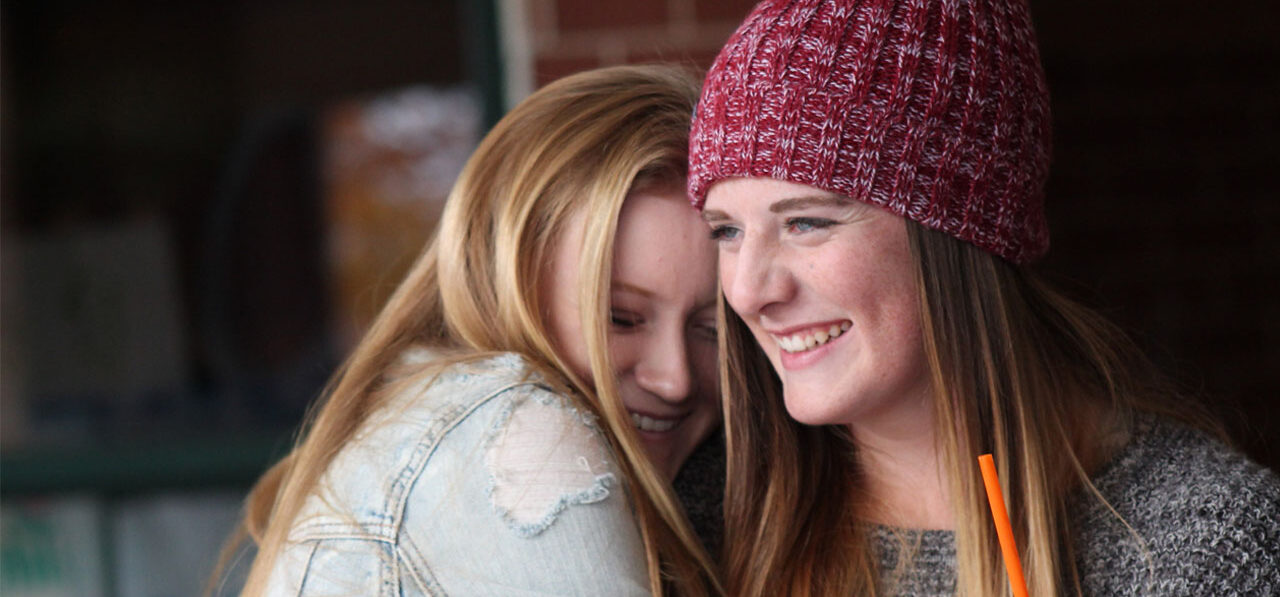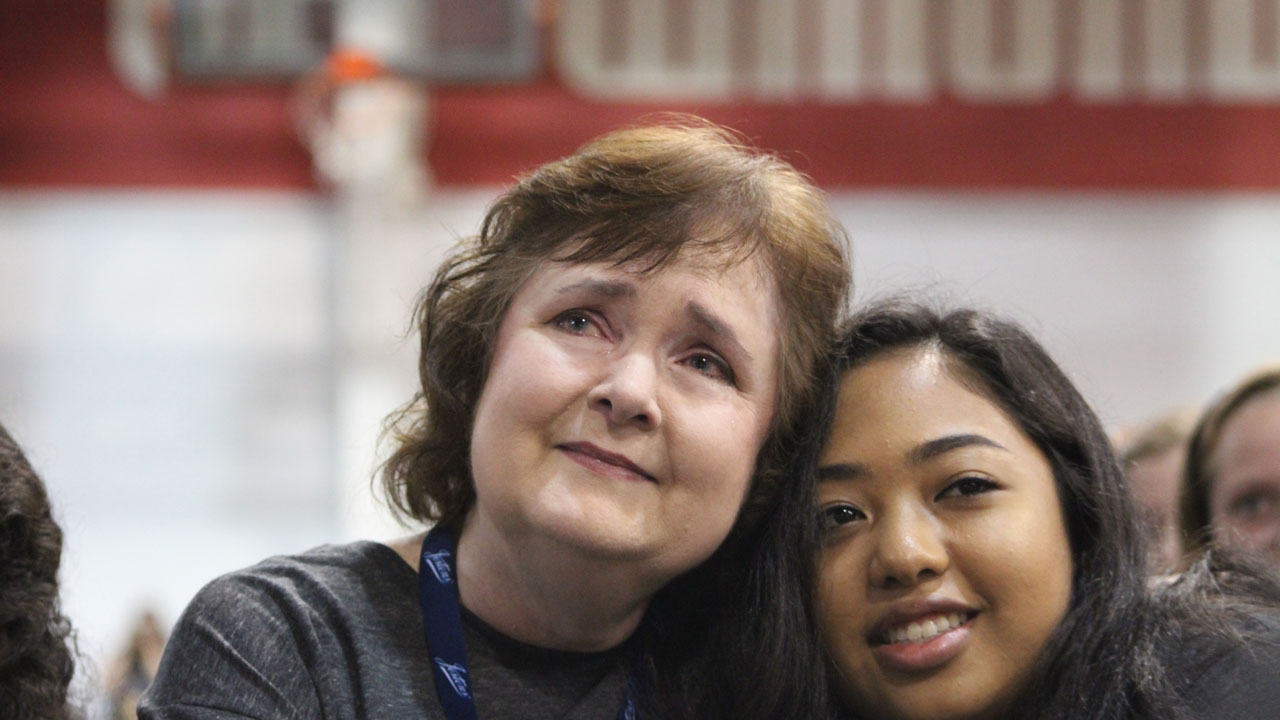One friend, one person who is truly understanding, who takes the trouble to listen to us as we consider our problems, can change our whole outlook on the world. – Psychologist Elton Mayo
“Listen up!” When that command echoes through a classroom, it most often signals that students need to listen to a teacher, coach, or other adult. But it’s a phrase teachers might use more in encouraging students to “listen up!” to each other.
Sure, students talk a lot with each other, whether it’s in person or via social media. It can be hard to get them to stop! But unlike talking, it’s much harder to really listen well to each other. In fact, really listening is a skill or habit many of us struggle to do all of our lives.
Active listening — which goes beyond hearing words — is the starting point for expressing care. It’s a habit and a skill that young people can, and need to, develop as they grow up. Not only will it help classroom relationships right now, but listening skills serve them well in the long term. After all, “listening effectively to decipher meaning” is a core 21st century skill.
Helping students learn to express care for each other by listening to each other is a key strategy for strengthening student-to-student relationships. These research insights and classroom activities highlight the potential ways educators can strengthen peer-to-peer relationships, which can go a long way to enhancing the culture and climate of your classroom and school.
The Critical Role of Friends who Listen
It’s not news that peer relationships become more important as students grow through middle school and high school. This shift reflects a critical developmental task of adolescence: developing a self-understanding or sense of identity. Having friends who know how to listen well becomes an invaluable resource for students’ development. Through self-disclosure, openness, intimacy and trust with friends, young people internalize who they are and how they relate to others.
Listening: The Foundation of Empathy
A key way to develop empathy is to have students share their own experiences and listen to each other’s stories. Through listening to, understanding, and identifying with the experiences of others, young people build bridges across differences and they learn about themselves in the process. Having opportunities to listen and be listened to can be transformative. As a young person said about a program that emphasizes telling your own stories: “This program, there’s so much honesty. It’s like you learn to be honest with yourself and the people around you, and everyone’s listening for once.”
Learning to Listen
Learning to listen — not just hear words — is a skill we develop as a way of expressing care for each other. What does it take? Psychologist Barbara Varenhorst, who pioneered teaching students to develop listening skills, identifies keys to learning to listen:
- Practice – Listening is a skill we learn by doing.
- Focus – Listening requires putting aside, at least temporarily, one’s own concerns or interests to be really present for another person.
- Empathy – Listening requires trying to experience what the other person is experiencing. In the process, a good listener can help others sort out what they want to say, and in the process help them learn more about themselves.
- Feedback – Listening involves sharing what we think we have heard to check for misunderstanding or incomplete ideas.
- Desire – Really listening requires really being interested in the other person and wanting to listen and learn from them.
Good Listeners: Trampolines, Not Sponges
Sometimes we think of good listeners as being like sponges: they just absorb everything they hear. But leadership development consultants who studied effective listeners in the workplace say they are more like trampolines than sponges. Great listeners, they write, are people “you can bounce ideas off of — and rather than absorbing your ideas and energy, they amplify, energize, and clarify your thinking.” By comparing differences between people who were seen as really good listeners and those who were average listeners, the researchers found that the really good listeners do the following:
- Ask questions that promote discoveries by constructively challenging old assumptions and offering relevant new insights.
- See conversation as an active, two-way dialogue, not a speaker-and-listener interaction. Both people have a chance to listen and contribute.
- Make the conversation positive for the other person by conveying a sense of confidence in them and letting them know you support them. That which doesn’t happen when you’re passive or critical.
- Make it safe to talk about differences of opinion openly without becoming defensive. Poor listeners tend to be seen as competitive debaters, who listen to find mistakes in the other person’s argument or use silence to prepare their response.
- Good listeners may disagree and challenge assumptions, but they do it in ways that show they are trying to help, not trying to win. They often frame their responses as suggestions, rather than jumping in to solve the problem.
Can You Really Listen When You’re Always on Social Media?
Most teens seem to be constantly connected to each other through social media. But are they really listening to each other in their texts and posts? Some researchers, educators, and parents worry that they’re not really listening and developing the kind of empathy that comes with listening in more than sound bites.
For example, MIT’s Sherry Turkle worries that teens “tend to talk about what’s on their phones, not what’s on their minds” or “what’s going on in their lives.” She worries that use of social media and other technologies tend to reduce deep empathy in relationships. When on social media, the connections tend to be more superficial, without the deep listening and sharing that cultivate empathy. She writes:
In the short term, online communication makes us feel more in charge of our time and self-presentation. If we text rather than talk, we can have each other in amounts we can control. And texting and email and posting let us present the self we want to be. We can edit and retouch… But human relationships are rich, messy, and demanding. When we clean them up with technology, we move from conversation to the efficiencies of mere connection.
Other researchers have found that young people mostly use social media to extend and help maintain face-to-face friendships, rather than replacing them. Furthermore, online interactions enhance relationships for some young people.
Questions remain about specific ways social media and technology enhance or undermine youth listening to each other. It’s likely, however, that developing strong listening skills in general will help deepen young people’s relationships both online and offline.
The Big Deal about “Small Talk”
It’s easy to dismiss “superficial” conversations as unimportant. But researchers find that “small talk” — catching up, reminiscing, talking about TV shows or cat videos on YouTube, and joking around — can help to keep relationships strong.
Although small talk is not enough by itself to sustain a strong relationship, these day-to-day conversations help to create a sense of being connected. If we don’t talk about the “little stuff,” we lose track of the everyday stories and experiences that make up our lives.
What might this mean for educators? Listening to (and participating in) students’ everyday banter can be an important part of building connections. In addition, giving students opportunities to connect with each other can help maintain a sense of connection so they are more comfortable talking with each other about deeper or more significant issues.
Helping Students Learn to Really Listen to Each Other
Be warm.
When teachers are caring in their relationships with students, students are more likely to be warm and caring in their relationships with each other.
Check in together.
Create opportunities for students to check in with each other, highlighting everyday things they are doing and experiencing. This helps them feel more connected to each other and opens up opportunities to connect at deeper levels.
Model listening.
When they experience someone who really listens to them, they will more likely try doing the same with their friends.
Set expectations.
Be clear about classroom norms around listening to each other and treating each other with respect. Students are more likely to share their own stories, thoughts, and opinions if they feel safe and know they won’t be ridiculed or put down for what they say.
Be explicit.
Sometimes debate and kinds of give-and-take interactions are important parts of classroom learning. Other times, though, students need to shift into “active listening” mode to empathize with each other. Help students learn to pay attention to these differences by naming them explicitly. Over time, they’ll pick up these “social cues” and respond appropriately.
Practice together.
Listening involves specific skills that can be broken down into steps and practiced. (See the Insights from Research section.) Take time to teach these skills, then reinforce them with reminders or other opportunities to practice them again through the school year.
Jostens partnered with Search Institute to provide research-based data and advice for dealing with common school challenges. Over the past 30 years, Search Institute has studied the strengths and difficulties in the lives of more than five million middle and high school youth across the country and around the world to understand what kids need in order to succeed. Like Jostens Renaissance, Search Institute focuses on young people’s strengths, rather than emphasizing their problems or deficiencies. Visit SearchInstitute.org to learn more.
Click the button below to download all research, references and activities related to the article above:
WANT TO USE JOSTENS RENAISSANCE?
If you are a Jostens customer and you need a login to access all the resources on JostensRenaissance.com, email your rep or click here.
If you don’t currently partner with Jostens for yearbooks or graduation regalia or other celebratory products, you can learn more here.


